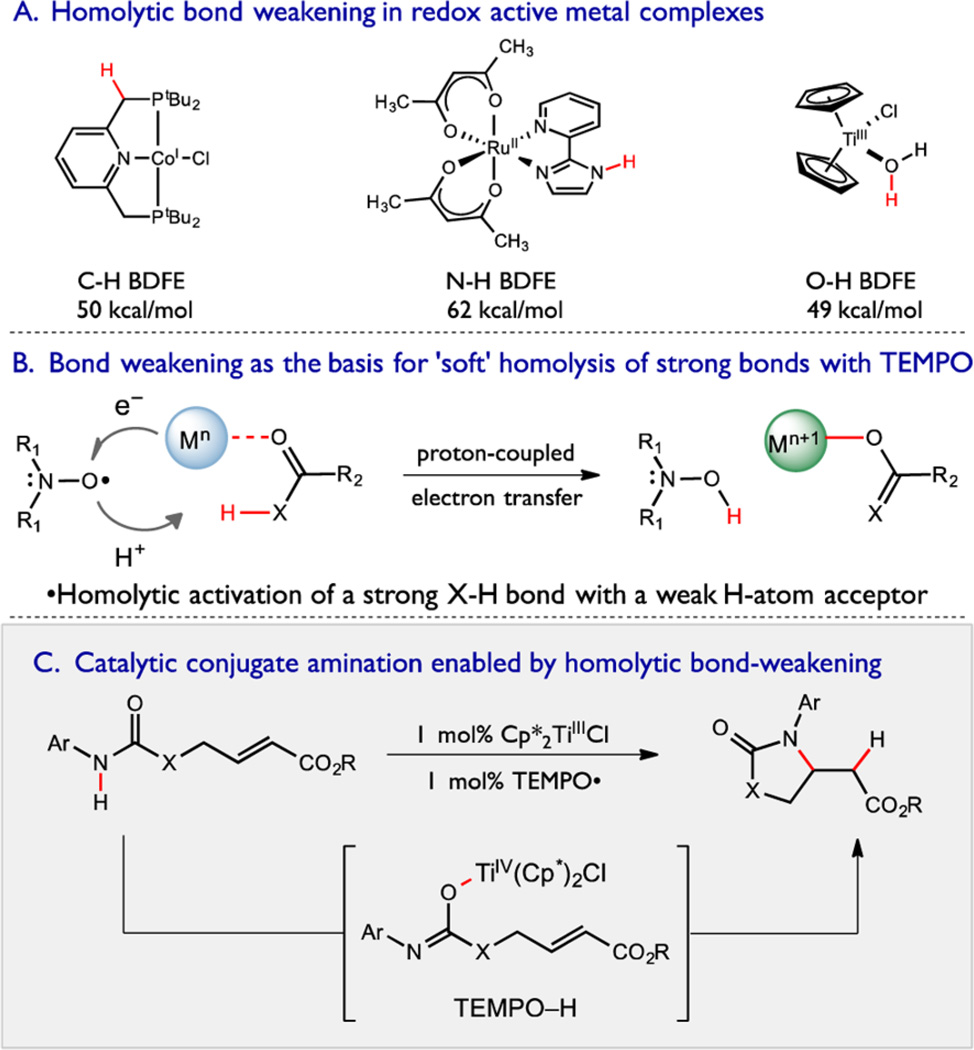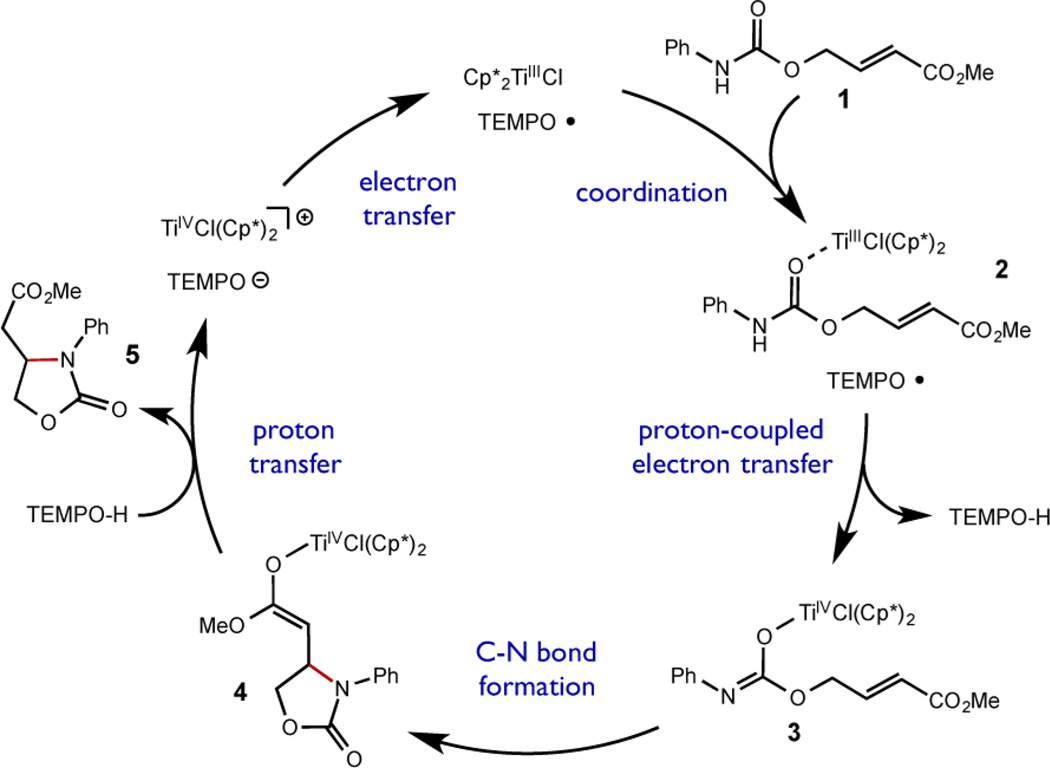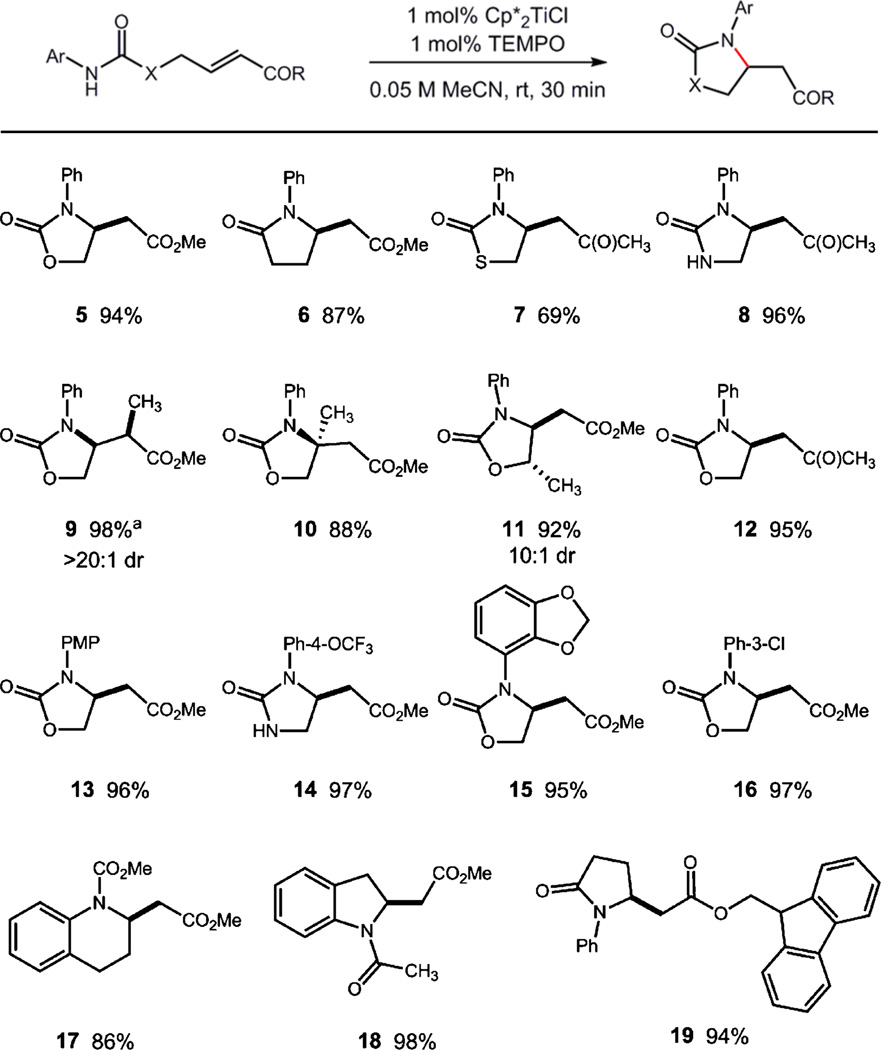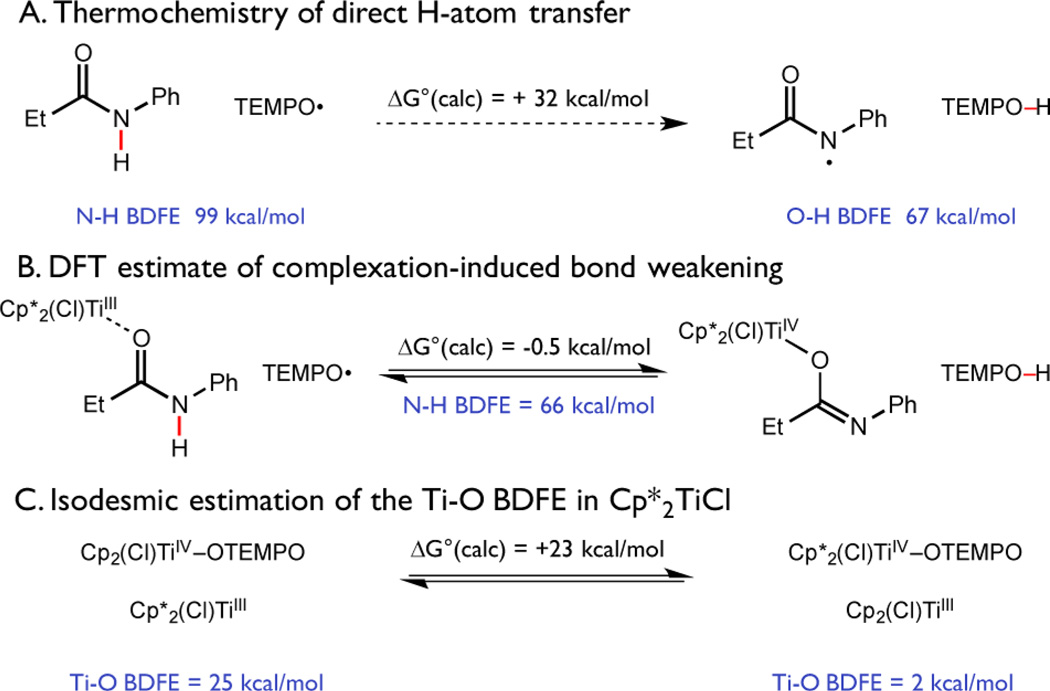Abstract
The ability of redox-active metal centers to weaken the bonds in associated ligands is well precedented, but has rarely been utilized as a mechanism of substrate activation in catalysis. Here we describe a catalytic bond-weakening protocol for conjugate amination wherein the strong N–H bonds in N-aryl amides (N–H bond dissociation free energies ~100 kcal/mol) are destabilized by ~33 kcal/mol upon by coordination to a reducing titanocene complex, enabling their abstraction by the weak H-atom acceptor TEMPO through a proton-coupled electron transfer process. Significantly, this soft homolysis mechanism provides a method to generate closed-shell, metalated nucleophiles under neutral conditions in the absence of a Brønsted base.
Accessing metalated intermediates under mild conditions is an enabling feature of many contemporary catalytic methods. For example, in electrophilic activation schemes, the Brønsted acidity of bonds in a ligated substrate are significantly increased through coordination to an electron-deficient metal,1 facilitating irreversible deprotonation by a comparatively weak Brønsted base. Such mechanisms are central to the success of the numerous metal-mediated C–H activation technologies,2 as well as the soft enolization protocols commonly used for the activation of carbonyl compounds.3 Analogously, coordination to redox-active metal centers can significantly decrease ligand homolytic bond strengths (Figure 1A).4 In these mechanisms, formal hydrogen atom transfer (HAT) from a datively coordinated ligand is kinetically coupled to one-electron (1e−) oxidation of the metal center and formation of a new M–X bond. When favorable, these changes can provide the driving force necessary to enable the homolysis of normally strong bonds with weak H-atom acceptors. While this manner of bond weakening has been observed for many different metals and ligand classes,4 and the degree of destabilization can be substantial, these mechanisms have not been systematically exploited in catalytic applications.5
Figure 1.
Complexation-induced bond weakening and design of catalytic amination protocol based on the soft homolysis of strong N–H bonds.
We recently questioned whether complexation-induced bond weakening could provide new opportunities to develop catalytic “soft” HAT processes. In such reactions, the bond dissociation free energies (BDFEs) of normally strong σ bonds in a substrate would be destabilized upon coordination to a reducing metal center, enabling formal HAT to TEMPO or a similarly weak H-atom acceptor via proton-coupled electron transfer (PCET).6 Rather than generating a free radical, this elementary step would directly furnish a closed-shell, organometallic intermediate that could be utilized in subsequent bond-forming processes (Figure 1B). From a synthetic perspective, such reactions would have value in their ability to generate metalated nucleophiles under neutral conditions in the absence of an identifiable Brønsted base. Toward this goal, we report here the development of a conjugate amination reaction between N-aryl amide derivatives and electron-deficient olefins jointly catalyzed by TEMPO and Cp*2TiIIICl (Figure 1C). The details of our study are outlined below, including kinetic, computational, and spectroscopic results that support bond weakening as the operative mechanism of substrate activation.
We first focused on identifying combinations of reducing metal centers and oxidizing H-atom acceptors that could function cooperatively to activate ligated substrates, but that would not react with each other directly. TEMPO was selected as the model H-atom acceptor given its ease of handling, commercial availability, and the strongly negative potentials required for its 1e− reduction (E1/2 = −1.95 V vs Fc/Fc+ in MeCN).7 In considering reducing metal complexes, we were initially drawn to pioneering work from Cuerva and co-workers on the bond-weakening ability of Cp2TiIIICl.8 In a particularly dramatic example, those authors estimated that the O–H bond dissociation energies in the aqua complex of this TiIII species are reduced by nearly 60 kcal/mol relative to the BDFE of free water (Figure 1A). In turn, this degree of weakening enables these aqua complexes to function as efficient stoichiometric H-atom donors for alkyl radicals.
While the capacity of these complexes to effect bond weakening was encouraging, we were mindful of reports from Waymouth and co-workers that Cp2TiIIICl readily reacts with TEMPO to form an isolable TiIV complex,9 albeit one that exhibits an unusually weak Ti–O bond. However, those authors further demonstrated that the strength of the Ti–TEMPO association can be modulated by modifying the ancillary cyclopentadienyl ligands,10 with the Ti–O bond in bulkier complexes being significantly destabilized. Along these lines, we questioned whether we could identify a sufficiently encumbered titanocene complex where complex formation with a large ligand such as TEMPO would be rendered thermodynamically unfavorable, but coordination to a less sterically hindered substrate would remain viable, leading to cooperative bond activation and formation of a metalated TiIV nucleophile.
Our initial efforts focused on developing methods for amide activation. Amide N–H bonds are homolytically strong (N–H BDFE ~110 and 100 kcal/mol for N-alkyl and N-aryl amides, respectively)11 and are energetically inaccessible as substrates for direct HAT to TEMPO (O–H BDFE in TEMPO-H 67 kcal/mol).7 However, upon complexation to TiIII, these N–H bonds might be weakened to the point that TEMPO can function as a formal H-atom acceptor, resulting in the formation of a metalated TiIV aza-enolate intermediate that could serve as a competent nucleophile in a range of C–N bond-forming reactions. To test these predictions, we elected to study the conjugate amination of carbamate 1 jointly catalyzed by TEMPO and a series of reduced titanocene complexes. We envisioned a plausible catalytic cycle (Scheme 1) wherein 1 would first bind to the titanocene to furnish complex 2. This coordination event would weaken the carbamate N–H bond sufficiently to render proton-coupled electron transfer by TEMPO thermodynamically favorable and afford a closed-shell, TiIV aza-enolate intermediate 3.6,12 Conjugate addition of this metalated nucleophile to the pendant olefin acceptor followed by metal migration would result in the formation of titanium enolate 4 that could undergo proton exchange with reduced TEMPO-H to furnish a neutral closed-shell product.13,14 Electron transfer from the strongly reducing TEMPO anion (E1/2 = −1.95 V vs Fc/Fc+ in MeCN)7 to the TiIV cation (Ep = −1.44 V vs Fc/Fc+ in MeCN)15a is exergonic by ~500 mV and should readily regenerate the TiIII catalyst and TEMPO radical, closing the catalytic cycle.
Scheme 1.
Proposed Catalytic Cycle
To evaluate this design, we evaluated a series of sterically differentiated titanocene catalysts in conjunction with TEMPO in the conjugate amination of carbamate 1 (Table 1). Unsubstituted and monosubstituted titanocenes capable of forming strong complexes with TEMPO were not catalytically active and returned the starting material unchanged (entries 1, 2). The preformed Cp2TiIV(Cl)–TEMPO complex was similarly ineffective (entry 3). However, the more reducing and sterically hindered Cp*2TiIIICl and mixed-ring Cp(Cp*)TiIIICl both proved to be effective catalysts and afforded the product in nearly quantitative yield after 1 h (entries 4, 5). As suggested above, this difference in reactivity likely results from the increased steric bulk imparted by the pentamethylcyclopentadienyl ligands, which precludes strong association to TEMPO (vide infra). This model reaction proceeds well in MeCN and DMF, but functions poorly in less coordinating aromatic, ethereal, and chlorinated solvents (entries 5–9). Other stable nitroxyls, such as AZADO (2-azaadamantane N-oxyl), were also found to be catalytically competent in these reactions (entry 10). Control experiments confirmed that the reaction does not proceed in the absence of either TiIII or nitroxyl catalyst or with related TiIV complexes (entries 11–13). Finally, the cyclization of 1 was shown to proceed with similar efficiency with only 1 mol % of both catalysts (entry 14).
Table 1.
Optimization Studiesa
 | ||||
|---|---|---|---|---|
| entry | Ti catalyst | nitroxyl catalyst | solvent | % yield |
| 1 | Cp2TiCl | TEMPO | MeCN | 0 |
| 2 | (t-BuCp)2TiCl | TEMPO | MeCN | 0 |
| 3 | Cp2TiIVCl(TEMPO) | TEMPO | MeCN | 0 |
| 4 | Cp(Cp*)TiCl | TEMPO | MeCN | 95 |
| 5 | Cp*2TiCl | TEMPO | MeCN | 98 |
| 6 | Cp*2TiCl | TEMPO | DMF | 96 |
| 7 | Cp*2TiCl | TEMPO | C6H6 | 15 |
| 8 | Cp*2TiCl | TEMPO | THF | 25 |
| 9 | Cp*2TiCl | TEMPO | DCM | 20 |
| 10 | Cp*2TiCl | AZADO | MeCN | 96 |
| 11 | - | TEMPO | MeCN | 0 |
| 12 | Cp*2TiCl | - | MeCN | 0 |
| 13 | Cp*2TiIVCl2 | TEMPO | MeCN | 0 |
| 14a | Cp*2TiCl | TEMPO | MeCN | 95 |
Optimization reactions performed at 0.05 mmol scale. Yields determined by 1H NMR analysis of the crude reaction mixture relative to an internal standard.
Reaction performed using 1 mol % of Cp*2TiCl and 1 mol % TEMPO.
Having identified optimal conditions for the TiIII-catalyzed cyclization of 1, we next conducted a preliminary survey of the scope of this process. On preparative scale, model carbamate 1 rapidly cyclized to give oxazolidinone 5 in 94% isolated yield (Table 2). N-Aryl amides were also viable substrates, providing N-phenylpyrrolidone 6 and N-acetylindoline 18 in 87% and 98% yield, respectively. Other heteroatoms were successfully incorporated to afford thiazolindinone 7 and imidazolidinones 8 and 14 from the corresponding thiocarbamate and urea starting materials. Gratifyingly, substrates containing α-Me or γ-Me substituents cyclized with high diastereoselectivity, giving products 9 and 11 in high yields. A substrate bearing a β-Me substituent readily cyclized to furnish adduct 10, which features a fully substituted tertiary carbinamine center. An ortho-substituted phenylcarbamate successfully cyclized to form tetrahydroquinoline 17 in 86% yield. Products 7, 8, and 12 were generated in high yield through conjugate addition to enones, and no ketyl-derived side products were observed.16 Electronically distinct substitution of the aryl group was possible, providing heterocycles 13, 14, and 16 in nearly quantitative yield, as well as ortho-substituted benzodioxole 15 with similar efficiency. To demonstrate that these reactions proceed under effectively neutral conditions, a base-labile fluorenylmethyl ester was prepared and successfully cyclized to afford 19 in 94% yield with no detectable loss of the ester protecting group. Notably, cyclization to form 19 using standard Brønsted bases, such as KOtBu in THF, led to quantitative ester deprotection. These conditions were not effective for intermolecular alkylation reactions or for the alkylations of N-alkyl amide substrates (N–H BDFEs ~110 kcal/mol). Efforts to address these limitations are currently ongoing.
Table 2.
Conjugate Amination Productsa
Reactions performed at 0.5 mmol scale unless otherwise noted. Yields are for purified material. Diastereomeric ratios determined by analysis of the 1H NMR spectra of the crude reaction mixtures.
Reaction run at 0.05 mmol scale.
Experimental and theoretical observations are consistent with the proposed soft homolysis mechanism of substrate activation. First, the degree of bond weakening resulting from coordination of the N-phenyl propionamide to Cp*2TiCl was assessed through density functional calculations (UB3LYP/6-31G(d) CPCM(MeCN). These studies indicated that the N–H bond strength decreased from 99 to 66 kcal/mol upon coordination to Cp*2TiCl (Scheme 2), a weakening effect of 33 kcal/mol.17,18 Notably, this value is sufficiently low that abstraction from the N–H bond to TEMPO is excepted to be nearly thermoneutral (O–H BDFE for TEMPO-H 67 kcal/mol). The analogous carbamate substrates were even further destabilized, with N–H bonds weakened by 39 kcal/mol.19
Scheme 2.
DFT Calculations (UB3LYP 6-31G(d) CPCM(MeCN))
Next, we sought to demonstrate the compatibility of the titanium reductant and nitroxyl oxidant in solution. Isodesmic calculations indicated that the bonding between Cp*2TiCl and TEMPO is 23 kcal/mol less favorable than in the TEMPO complex of Cp2TiCl, which Waymouth reported to have a Ti–O BDFE ~25 kcal/mol.10,15b This implies that the Ti–O bond for the TEMPO complex of Cp*2TiCl is exceptionally weak, with a BDFE only ~2 kcal/mol.18 Additional experimental support for the ability of TEMPO and Cp*2TiCl to persist together in solution was obtained through EPR spectroscopy. Solutions containing equal amounts of TEMPO and Cp*2TiCl in MeCN at room temperature produced spectra where signals from both species were simultaneously observable (Figure 2). This is consistent with the notion that the equilibrium for bonding between these species in solution is not highly favorable, and that meaningful concentrations of both oxidant and reductant can exist in solution on the time scale of the amination reaction. Inclusion of 1 equiv of carbamate 1 in these solutions also resulted in no observable spectral changes, suggesting a solvent-bound resting state for the titanocene catalyst.19–21
Figure 2.
EPR spectra and simulations demonstrating compatibility of Cp*2TiCl and TEMPO in MeCN solution.
Lastly, preliminary kinetic studies of the model amination reaction revealed first-order rate dependencies on the concentrations of carbamate 1, Cp*2TiIIICl, and TEMPO. In addition, a significant primary kinetic isotope effect of 7 ± 1 was observed by comparing the rates of individual reactions run with N–H and N–D isotopologues of 1. These computational, spectroscopic, and kinetic data are consistent with a soft homolysis mechanism of substrate activation involving rate-limiting N–H abstraction from the Cp*2TiIIICl complex of 1 by TEMPO.
In conclusion, we have developed a conjugate amination protocol jointly catalyzed by Cp*2TiCl and TEMPO wherein a variety of evidence suggests that substrate activation occurs through complexation-induced bond weakening. More generally, the compatibility of the Cp*2TiCl–TEMPO system in this work suggests an intriguing 1e− parallel to frustrated Lewis pair chemistry, where sterically encumbered partners are not able to react with one another, but still function cooperatively to effect substrate bond activation. We anticipate that the elements of reaction design presented herein are general and will provide a basis for the development of other transformations that operate by a similar principle.
Supplementary Material
ACKNOWLEDGMENTS
Financial support was provided by Princeton University and the NIH (R01 GM113105). We thank Iraklis Pappas, Brian Schaefer, and Paul Chirik for helpful discussions and a generous gift of titanocene complexes. R.R.K. is a fellow of the Sloan Foundation.
Footnotes
ASSOCIATED CONTENT
Supporting Information
Experimental procedures, computational results, kinetic data, and characterization data. The Supporting Information is available free of charge on the ACS Publications website at DOI: 10.1021/jacs.5b03428.
The authors declare no competing financial interest.
REFERENCES
- 1.(a) Gorelsky SL, Lapointe D, Fagnou K. J. Am. Chem. Soc. 2008;130:10848. doi: 10.1021/ja802533u. [DOI] [PubMed] [Google Scholar]; (b) Ryabov AD. Chem. Rev. 1990;90:403. [Google Scholar]; (c) Ackermann L, Vicente R, Kapdi AR. Angew. Chem. Int. Ed. 2009;48:9792. doi: 10.1002/anie.200902996. [DOI] [PubMed] [Google Scholar]; (d) Davies DL, Donald SMA, Macgregor SA. J. Am. Chem. Soc. 2005;127:13754. doi: 10.1021/ja052047w. [DOI] [PubMed] [Google Scholar]; (e) Boutadla Y, Davies DL, Macgregor SA, Poblador-Bahamonde AI. Dalton Trans. 2009:5820. doi: 10.1039/b904967c. [DOI] [PubMed] [Google Scholar]; (f) Vigalok A, Uzan O, Shimon LJW, Ben-David Y, Martin JML, Milstein D. J. Am. Chem. Soc. 1998;120:12539. [Google Scholar]
- 2.(a) Ackermann L. Chem. Rev. 2011;111:1315. doi: 10.1021/cr100412j. [DOI] [PubMed] [Google Scholar]; (b) Trost BM, Fullteron TJ. J. Am. Chem. Soc. 1973;95:292. [Google Scholar]; (c) Chen MS, White MC. J. Am. Chem. Soc. 2004;126:1346. doi: 10.1021/ja039107n. [DOI] [PubMed] [Google Scholar]; (d) Young AJ, White MC. J. Am. Chem. Soc. 2008;130:14090. doi: 10.1021/ja806867p. [DOI] [PubMed] [Google Scholar]; (e) Stuart DR, Fagnou K. Science. 2007;316:1172. doi: 10.1126/science.1141956. [DOI] [PubMed] [Google Scholar]; (f) Lane BS, Brown MA, Sames D. J. Am. Chem. Soc. 2005;127:8050. doi: 10.1021/ja043273t. [DOI] [PubMed] [Google Scholar]; (g) Periana RA, Taube DJ, Gamble S, Taube H, Satoh T, Fujii H. Science. 1998;280:560. doi: 10.1126/science.280.5363.560. [DOI] [PubMed] [Google Scholar]; (h) Chen X, Engle KM, Wang D, Yu J. Angew. Chem. Int. Ed. 2009;48:5094. doi: 10.1002/anie.200806273. [DOI] [PMC free article] [PubMed] [Google Scholar]; (i) Xiao B, Fu Y, Xu J, Gong T, Dai J, Yi J, Liu L. J. Am. Chem. Soc. 2010;132:468. doi: 10.1021/ja909818n. [DOI] [PubMed] [Google Scholar]; (j) Dick AR, Hull KL, Sanford MS. J. Am. Chem. Soc. 2004;126:2300. doi: 10.1021/ja031543m. [DOI] [PubMed] [Google Scholar]
- 3.(a) Evans DA, Bartroli J, Shih TL. J. Am. Chem. Soc. 1981;103:2127. [Google Scholar]; (b) Crimmins MT, King BW, Tabet EA, Chaudhary K. J. Org. Chem. 2001;66:894. doi: 10.1021/jo001387r. [DOI] [PubMed] [Google Scholar]; (c) Lim D, Fang F, Zhou G, Coltart DM. Org. Lett. 2007;9:4139. doi: 10.1021/ol701599v. [DOI] [PubMed] [Google Scholar]; (d) Zhou G, Lim D, Coltart DM. Org. Lett. 2008;10:3809. doi: 10.1021/ol801498u. [DOI] [PubMed] [Google Scholar]; (e) Evans DA, Tedrow JS, Shaw JT, Downey CW. J. Am. Chem. Soc. 2002;124:392. doi: 10.1021/ja0119548. [DOI] [PubMed] [Google Scholar]
- 4.(a) Estes DP, Grills DC, Norton JR. J. Am. Chem. Soc. 2014;136:17362. doi: 10.1021/ja508200g. [DOI] [PubMed] [Google Scholar]; (b) Roth JP, Mayer JM. Inorg. Chem. 1999;38:2760. doi: 10.1021/ic990251c. [DOI] [PubMed] [Google Scholar]; (c) Manner VW, Mayer JM. J. Am. Chem. Soc. 2009;131:9874. doi: 10.1021/ja902942g. [DOI] [PMC free article] [PubMed] [Google Scholar]; (d) Jonas RT, Stack TDP. J. Am. Chem. Soc. 1997;119:8566. [Google Scholar]; (e) Semproni SP, Milsmann C, Chirik PJ. J. Am. Chem. Soc. 2014;136:9211. doi: 10.1021/ja504334a. [DOI] [PubMed] [Google Scholar]; (f) Fang H, Ling Z, Lang K, Brothers PJ, Bruin B, Fu X. Chem. Sci. 2014;5:916. [Google Scholar]; (g) Miyazaki S, Kojima T, Mayer JM, Fukuzumi S. J. Am. Chem. Soc. 2009;131:11615. doi: 10.1021/ja904386r. [DOI] [PMC free article] [PubMed] [Google Scholar]; (h) Wu A, Mayer JM. J. Am. Chem. Soc. 2008;130:14745. doi: 10.1021/ja805067h. [DOI] [PMC free article] [PubMed] [Google Scholar]; (i) Wu A, Masland J, Swartz RD, Kaminsky W, Mayer JM. Inorg. Chem. 2007;46:11190. doi: 10.1021/ic7015726. [DOI] [PMC free article] [PubMed] [Google Scholar]; (j) Milsmann C, Semproni SP, Chirik PJ. J. Am. Chem. Soc. 2014;136:12099. doi: 10.1021/ja5062196. [DOI] [PubMed] [Google Scholar]
- 5.Wood and Renaud reported pioneering synthetic examples of bond weakening wherein stoichiometric borane complexes of water or aliphatic alcohols serve as H-atom donors to alkyl radicals: Spiegel DA, Wiberg KB, Schacherer LN, Medeiros MR, Wood JL. J. Am. Chem. Soc. 2005;127:12513. doi: 10.1021/ja052185l. Pozzi D, Scanlan EM, Renaud P. J. Am. Chem. Soc. 2005;127:14204. doi: 10.1021/ja055691j.
- 6. Warren JJ, Menzeleev AR, Kretchmer JS, Miller TF, III, Gray HB, Mayer JM. J. Phys. Chem. Lett. 2013;4:519. doi: 10.1021/jz400029w. Warren JJ, Mayer JM. J. Am. Chem. Soc. 2011;133:8544–8551. doi: 10.1021/ja201663p. Manner VW, DiPasquale AG, Mayer JM. J. Am. Chem. Soc. 2008;130:7210. doi: 10.1021/ja801672w. (d) Reference 4b.
- 7.Warren JJ, Tronic TA, Mayer JM. Chem. Rev. 2010;110:6961. doi: 10.1021/cr100085k. [DOI] [PMC free article] [PubMed] [Google Scholar]
- 8.(a) Campana AG, Estevez RE, Fuentes N, Robles R, Cuerva JM, Bunuel E, Cardenas D, Oltra JE. Org. Lett. 2007;9:2195. doi: 10.1021/ol070779i. [DOI] [PubMed] [Google Scholar]; (b) Paradas M, Campaña AG, Jiménez T, Robles R, Oltra JE, Buñuel E, Justicia J, Cárdenas DJ, Cuerva JM. J. Am. Chem. Soc. 2010;132:12748. doi: 10.1021/ja105670h. [DOI] [PubMed] [Google Scholar]; (c) Cuerva JM, Campana AG, Justicia J, Rosales A, Oller-Lopez JL, Robles R, Cardenas DJ, Bunuel E, Oltra JE. Angew. Chem. Int. Ed. 2006;45:5522. doi: 10.1002/anie.200600831. [DOI] [PubMed] [Google Scholar]
- 9.Huang K, Waymouth RM. J. Am. Chem. Soc. 2002;124:8200. doi: 10.1021/ja0264854. [DOI] [PubMed] [Google Scholar]
- 10.(a) Huang K, Han JH, Cole AP, Musgrave CB, Waymouth RM. J. Am. Chem. Soc. 2005;127:3807. doi: 10.1021/ja044512f. [DOI] [PubMed] [Google Scholar]; (b) Huang K, Han JH, Musgrave CB, Waymouth RM. Organometallics. 2006;25:3317. [Google Scholar]
- 11.Bordwell FG, Zhang S, Zhang X, Liu W. J. Am. Chem. Soc. 1995;117:7092. [Google Scholar]
- 12.The orbital origin of the transferring electron in these bond activations (from titanium or localized in the N–H σ bond) is not clear. We favor concerted PCET as the mechanism based on prior work (including refs 6a–d) but acknowledge that HAT cannot be discounted.
- 13.Alternatively, direct HAT from TEMPO-H to the Ti(IV) enolate in Scheme 1 is calculated to be favorable by 14 kcal/mol and is a plausible alternative mechanism for regeneration of the Ti(III) catalyst and TEMPO. See Supporting Information (SI) for details.
- 14.A reviewer suggested that thermal homolysis of the Ti–Obond in the Ti(IV) enolate followed by the HAT from TEMPO-H to the α-carbonyl free radical as a possible alternative mechanism.
- 15.(a) Gansäuer A, Kube C, Daasbjerg K, Sure R, Grimme S, Fianu GD, Sadasivam DV, Flowers RA., II J. Am. Chem. Soc. 2014;136:1663. doi: 10.1021/ja4121567. [DOI] [PubMed] [Google Scholar]; (b) Gansäuer A, von Laufenberg D, Kube C, Dahmen T, Michelmann A, Behlendorf M, Sure R, Seddiqzai M, Grimme S, Sadasivam DV, Fianu GD, Flowers RA., II Chem.—Eur. J. 2015;21:280. doi: 10.1002/chem.201404404. [DOI] [PubMed] [Google Scholar]
- 16.For examples of titanocene-catalyzed reactions that tolerate ketone functionality, see: Zhao Y, Weix DJ. J. Am. Chem. Soc. 2014;136:48. doi: 10.1021/ja410704d. Morcillo SP, Miguel D, Campana AG, Alvarez de Cienfuegos L, Justicia J, Cuerva JM. Org. Chem. Front. 2014;1:15.
- 17.Homolytic bond weakening is not a simple Lewis-acid-mediated process. The N–H BDFE of N-phenyl propionamide bound to BF3, a non-redox-active Lewis acid, is calculated to be 99 kcal/mol.
- 18.All thermochemical parameters were also calculated using the LANL2DZ functional, with very similar results. See SI.
- 19.See SI for details.
- 20.Calculations indicate that amide binding is endergonic by ~10 kcal/mol. See SI.
- 21.A reviewer suggested that titanocenium cations may also be active bond-weakening agents in these reactions. For related work, see: Gansäuer A, Hildebrandt S, Michelmann A, Dahmen T, von Laufenberg D, Kube C, Fianu GD, Flowers RA., II Angew. Chem. Int. Ed. 2015 doi: 10.1002/anie.201501955.
Associated Data
This section collects any data citations, data availability statements, or supplementary materials included in this article.







